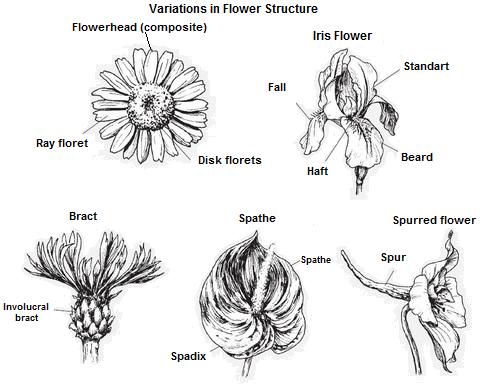|

Many plant species produce flowers that deviate from the idealized format. Certain lilies, for example, do not have sepals and petals that are clearly distinguishable from each other. In magnolias and some water lilies, each flower produces perianth parts that intergrade from a sepal-like form toward the outside to a petallike form toward the inside.
Many flowers have evolved to become simpler and are called incomplete flowers, they may lack one or more sets of parts. Apetalous flowers have only sepals, although some, such as those of the liverleaf and anemone, may be petallike. Elms, mulberries, oaks, plantains, pigweeds, and goosefeet have sepals that remain green and are usually tiny. Naked flowers, including those of birches and willows, develop neither sepals nor petals. Grass flowers are associated with tiny green parts called bracts, which are neither sepals nor petals. The nature of the perianth is related to the way a plant undergoes pollination. Flowers with a well developed corolla or a calyx made up of petal-like sepals are attractive to animals and insects, which function to pollinate them. Apetalous and naked flowers are wind-pollinated, they do not need to waste their energy making showy flower parts.
Some incomplete flowers lack either the androecium or the gynoecium. These imperfect flowers are unisexual and fall into two categories: staminate flowers are male flowers, having only stamens and no pistils, pistillate flowers are female, having only pistils and no stamens. Forced into cross-pollination, imperfect flowers benefit the plant by preventing some of the harm inherent in self-pollination. In the idealized flower, the parts are free down to the receptacle. Many flowers, however, exhibitconnation, in which similar parts are fused above the receptacle. The petals of the morning glory are fused to form a funnel-shaped corolla. Carnations have connate sepals, forming a calyx tube. Many plants have pistils composed of individual fused segments, called carpels, while others, such as the mallow, have connate stamens, forming a stamen tube.
Other flowers show adnation, which involves the fusion of different parts. The stamens of phlox flowers are fused to the petals. The sepals, petals, and stamens of roses are all fused, forming a cup-shaped structure called a hypanthium. The presence of a hypanthium can be best observed in plum and cherry blossoms, whose individual sepals, petals, and stamens are attached to the rim of the hypanthium. Finally, many flowers have a hypanthium that is fused to the wall of the ovary. The result is that the sepals, petals, and stamens emerge from the top of the ovary, a good example being the apple blossom. Flowers of the latter category are said to have an inferior ovary, whereas the others have superior ovaries.
Flowers corollas also vary: In flowers with a regular corolla, such as buttercups, lilies, and roses, all the petals are equal in size and shape, giving the flower a star shape. In flowers with irregular corollas, such as the snapdragon, pea, and orchid, one or more of the petals are unequal. Some irregular flowers, such as the violet, touch-me-not, and columbine, have a rounded, cone-shaped, or pointed extension of the corollacalled a spur, which serves to store nectar.
Although not technically floral structures, color, shape, and inflorescences (the loose or dense clusters in which flowers appear on a plant) are other ways in which flowers differ, important because they allow certain pollinators to enter but exclude others. Bowlshaped flowers are visited by a variety of insects, such as beetles and bees. Irregular flowers are typically pollinated by honeybees and bumblebees, and in some cases the insects fit the flower like a key fits a lock. Flowers with long spurs are pollinated by long-tongued insects such as moths. Color, determined by special molecules called pigments that occur within the cells of the plant, attracts different pollinators as well: red flowers are pollinated by birds, specifically hummingbirds and butterflies. White flowers are often open at night and are visited by moths. One group of plants have brown or maroon flowers and an odor of rotting flesh. These "carrion flowers" are pollinated by an array of insects, particularly beetles and flies. Interestingly, the way that humans perceive color is often different from the way that other animals perceive color. For example, xanthophylls reflect not only yellow but also a deep violet that bees can perceive but that humans cannot.
See also: Fruit Structure, Types of Inflorescence
|
